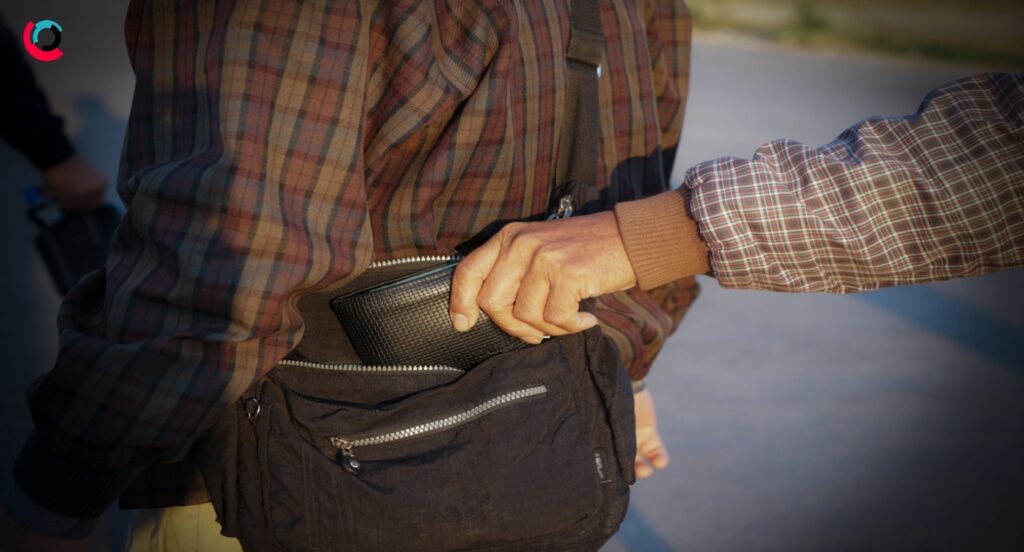by Farhan Rafi
Around half of business travellers extend their trip for leisure purposes, and by visiting popular tourist sites in a foreign city, you would be at a greater risk of encountering pickpockets. Pickpockets, conventionally defined as thieves who steal things out of pockets or bags, are consistently reported in the United Kingdom, with around 600,000 cases yearly.
Chances that you have stumbled upon videos about pickpocketing are high If you have scrolled through TikTok or Instagram lately, after a TikTok trend of a Venice-based woman yelling “attenzione borseggiatrici, attenzione pickpocket!”’ has gone viral. Poli’s vigilante content on TikTok, where she would foil pickpocket’s modus operandi, snowballed the public’s awareness of the topic, making the hashtag #pickpocket on TikTok boasting at least 1.5 billion views.
One of the best ways to not fall victim to pickpockets is to be familiar with their schemes.
Here are some of the most popular tactics when it comes to pickpocketing in European cities
In Paris’ Métro system, a popular pickpocket method is the “Crush and Grab”. Thieves would pick your pockets whilst several people push you, trying to board or offboard the train. Most pickpockets work in groups and are typically adolescents, as they might face fewer legal troubles if caught.
One common “diversion” pickpocketing technique in Barcelona is called “la Mancha”, where the victim is stained by a substance, and a thief approaches and alerts the victim of the stain and offers to help clean the stain off, during which they would pick the unsuspecting victim’s pocket. In 2018, the city reported 12 pickpocket cases per hour.
In London Underground stations, namely King’s Cross St Pancras, and Oxford Circus, the “Bottleneck” tactic is particularly popular. While an accomplice blocks the bottom of an escalator or the exit of a train carriage to pile people up as a means of fabricating a distraction, another thief pickpockets those looking ahead at the commotion. Another very common technique is “Moped Muggings”, where drive-by thieves on scooters would snatch wallets, phones, or bags from pedestrians. The United Kingdom reports about 16,000 cases of moped muggings each year.
In Rome, pickpockets may even occur in settings outside of prominent tourist sites or crowded areas, such as restaurants. Thieves may discreetly or not-so-discreetly grab an item from a bag or the whole bag from the back of the victim’s chair. The “Map” is a trick that is also frequently used on patrons of restaurants and cafés, where a thief would cover the victim’s line of sight with a large map or newspapers to steal things out of their bags placed on the table.
Other tactics
Across many European cities, thieves manoeuvre a wide array of “diversion” pickpocket techniques that are similar to “la Mancha”, such as the “Fake Tourist”, when thieves pretend to be tourists asking for directions to distract the victims. Another tactic – “Flower Giver”, is when a thief greets their victim by handing them a flower, allowing themself or another accomplice to commit the theft.
Although pickpockets follow patterns, sometimes they work alone and without any noteworthy technique. In general, you should be more careful while queueing at busy retail stores or boarding on public transit. Never leave your belongings unattended, especially at tourist attractions or crowded areas.
Riskline’s tips on how to protect your belongings from pickpockets:
- Keep most of your essentials at your accommodation (carrying one identification document and ATM card is sufficient)
- Be aware of your surroundings, remain vigilant and keep belongings within sight when in crowded settings
- Show confidence: pickpockets often take advantage of tired, disorientated and inattentive travellers to pickpocket or steal bags
- Stay away from doors and minimise distractions such as texting when on public transport
- Avoid using the phone in congested public areas. Muggings for mobile phones are particularly common, and phones often contain work data
- Do not carry belongings on your side that is facing the street when walking outdoors
- Refrain from storing essential items in the back pocket of your trousers or backpack
- Store your passport, keys, credit cards and travel documents in a crossbody bag positioned in front of you
- Have digital or hard copies of important identification documents
- Bonus tip! Locate your stolen devices through the Find My (iOS) or Find My Device (Android) apps. Give details on the stolen device’s location to local police
While pickpockets are more inclined to target tourists, they also often strike in settings attended by business travellers. In case of pickpocketing, do not attempt to chase down the thief and immediately block your credit cards. There is not much you can do in the follow-up of a pickpocket scam besides filing a report with the local authorities. Therefore, you should follow the above tips to minimise the risks of pickpockets.
Riskline’s Country Reports contain advisories about pickpocketing and petty crimes for more than 225 worldwide locations. Find out more about our products and solutions on Riskline.com.
